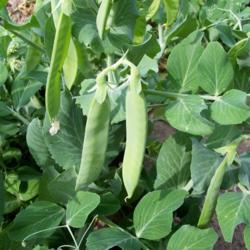
One of the best spring vegetables to grow is green peas. Because they're not always available in grocery stores, growing them yourself is the best way to be sure you'll get to enjoy these tasty treats. Plus, since they're an early spring vegetable, growing peas is a great way to start your vegetable gardening season.
Peas are easy to grow. The key is starting early and choosing the right type for your garden. Whether it be English peas for shelling, snow peas for stir frying, or snap peas for eating fresh from the garden, there are peas to suit your growing conditions and preferences. Here are some tips for growing an abundant crop in your yard.
Pea VarietiesFresh green peas are grouped into three categories: English peas, snap peas, and snow peas. While they all grow the same way, each has unique uses. Your first decision is which type of peas are right for you.
English Peas. Also known as shelling peas, these are the most common type of peas available. They are harvested when the pods are filled with seeds but before they mature and get tough. Some good varieties to try include the classic 'Wando' (good for freezing), 'Thomas Laxton' (high sugar content), 'Progress No. 9' (good disease resistance), and 'Little Marvel' (grows only 15 inches tall).
Snap Peas. Also known as edible-podded peas, these peas are unique for their tender pods. You can let them mature like English peas or harvest them when the peas have just started forming. In either case you can eat the whole pod.
Some good varieties to try are the original 'Sugar Snap', an early-maturing version called 'Early Snap' (produces peas 10 to 14 days earlier than 'Sugar Snap'), 'Sugar Ann' (grows only 2 feet tall), and 'Super Sugar Mel' (produces 4-inch-long, very sweet pods).
Snow Peas. This type of pea is common in Chinese cooking. These flat-podded peas are harvested as soon as the pods form but before the peas begin to expand. Some good varieties to try include 'Oregon Sugar Pod II' (grows only 2-1/2 feet tall) and 'Mammoth Melting Sugar' (wilt tolerant).
Growing PeasPeas are unique in the vegetable world because, being a legume, they can fix their own nitrogen fertilizer. They require little extra fertility to grow and produce. The key to growing peas is to plant them early enough in spring so they mature while the weather is still cool. This means planting in February, March, and April in most parts of the country.
They can even be grown as a fall or winter crop in warm areas of the country. Select a sunny location on well-drained soil. While peas can grow in part shade, they won't be as sweet as those grown in full sun. One of the few downfalls of growing peas is seed rot.
Don't plant in wet areas where the cool soil is conducive to the pea seeds rotting before they germinate. If necessary, raise the beds 6 to 8 inches high to provide a well-drained planting site.
As soon as the soil is dry enough to work, turn in a 2- to 3-inch-thick layer of compost. Plant peas 2 inches apart in double rows spaced 6 inches apart. Most varieties of peas require a pea fence to climb on while they grow. Install your fence of wire, rope, or twigs when planting so you don't disturb the peas later. The young tendrils will have something to climb on immediately after emerging from the soil.
Once germinated, your peas will climb the fence to anywhere between 2 and 8 feet tall, depending on the variety. If the weather is dry, water them periodically. Keep the pea bed well weeded, but be careful using weeding tools such as hoes because peas are shallow rooted.
The Pea HarvestMost varieties of peas are ready to harvest 60 to 70 days after planting. The exact time to harvest depends on the type of pea variety. Peas mature quickly, so check daily once you see the flowers in bloom. Pea pods that have hardened or turned a dull color are over mature and should be discarded.
Pinch off mature peas with your fingers or scissors so as not to disturb the vine. For a special treat, harvest the pea flowers or the last 4 inches of the pea shoots and toss them in a salad of fresh greens. After the pea harvest is finished, pull out the vines and plant another vegetable, such as lettuce or carrots, since it's still early in the growing season.
 Charlie Nardozzi is an award winning, nationally recognized garden writer, speaker, radio, and television personality. He has worked for more than 30 years bringing expert gardening information to home gardeners through radio, television, talks, tours, on-line, and the printed page. Charlie delights in making gardening information simple, easy, fun and accessible to everyone. He's the author of 6 books, has three radio shows in New England and a TV show. He leads Garden Tours around the world and consults with organizations and companies about gardening programs. See more about him at Gardening With Charlie.
Charlie Nardozzi is an award winning, nationally recognized garden writer, speaker, radio, and television personality. He has worked for more than 30 years bringing expert gardening information to home gardeners through radio, television, talks, tours, on-line, and the printed page. Charlie delights in making gardening information simple, easy, fun and accessible to everyone. He's the author of 6 books, has three radio shows in New England and a TV show. He leads Garden Tours around the world and consults with organizations and companies about gardening programs. See more about him at Gardening With Charlie.